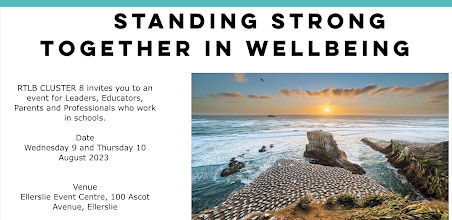Standing Strong Together in Wellbeing
This was the phrase was title given to the Nga Manu Awhina - RTLB cluster 8 event held last week. I attended on Thursday and heard a number of thought provoking presentations.
Two presentations were particularly salient for me.
Dr Melinda Webber - Akonga motivation, engagement and persistence at school - what matters?
Dr Webber presented her strength based research "Kia tu rangatira ai" and her collaboration on the Compass project - which you can access here. She outlined many of the factors which support the development of student mana across the domains of the Mana model (See Mitey for a full description of this model). Role models were shown to have a dramatic effect on the students motivation to engage in learning. Dr Webber suggests asking a student "Who shall I tell when you have done a good job?". I was struck with the simplicity of this statement and could see how immediately powerful it would be. Firstly it shows that you expect that the student will be successful! and it shows that you don't assume who is important to them - you want them to tell you who is the pillar in their life. This then allows the student and teacher to unpack why this person is important. What values do they represent in the students life? I think this is a practical thing I can do even for my very young learners. I really loved the challenge she laid down for educators to help our students to "plant the seeds of their imagined future self".
Kathryn Berkett - The Neuroscience of Trauma
Kathryn is a proponent of Trauma informed practise within educational settings. She gave a clear and concise description of brain development and the impact of trauma on that process. As teachers we see a range of behaviours exhibited in the classroom and the challenge for us is do increase the incidence of positive behaviours (as the education setting requires) and decrease the incidence of negative behaviours. Kathryn's mantra is increase the perception of safety and you will see these changes. By using the mnemonic..
Some Boys Have Mullets.... we can help our students to feel safe in our classrooms.
S - See me - spend time one on one with the student in a low stress activity e.g play, get to know who they are and what is important to them.
B - show me I Belong - ensure the student knows they are important in the class. Give them jobs/roles, make sure they have a physical space which feels safe.
H - let me know what is Happening - keep consistent routines within the day, be organised so I am calm in the classroom, and give the student lots of warning of changes.
M - empower my Mana - take a strength based approach and celebrate every success. (Kathryn highlighted that even a reduction in "negative" behaviour is indeed a success.)
Then create tolerable stress. Students should be assisted to develop a tolerance to stressors by short exposures which can push the student into red brain (see Kathryns explanation of Green/Red brain here) This should be frequent, gradual and can be described to the student in a way they can understand. E.g "we are going to assembly, I know you don't really like assembly cause its quite loud, but you can sit by me and leave in 10 minutes. Let's time it on my watch. Then you can go back to the classroom and play lego......Wow I was so impressed you managed to sit really still in assembly, I could tell you were concentrating on the watch counting down so you didn't think about the noise. Let's build that battleship you want to make."
Her message was really uplifting to me and reminded me that we can and do make a difference in our classrooms everyday.



Comments
Post a Comment